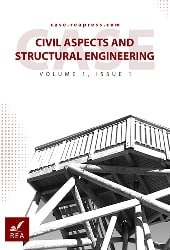Numerical Investigation of Seismic Behavior of Reinforced Concrete Dams Using the Finite Element Method (Case Study: Manjil Dam)
Abstract
Dam construction, as one of the oldest and most complex construction activities, has always been considered by different societies and is also considered one of the important economic resources of each country and region. Concern about the safety of dams has existed for a long time and is increasing day by day. The design and implementation of dams and their safety against earthquakes are of great importance. The main concept of safety is to prevent the failure of a dam and the uncontrolled overflow of the reservoir water with the occurrence of floods, which usually causes greater economic damage to the dam. To assess the safety and stability of existing dams, to determine the adequacy of the proposed reforms for the improvement and upgrading of old dams, and to evaluate the proposed designs for the construction of new dams, it is necessary to evaluate the effects of earthquakes on these dams. Predicting the behavior of concrete dams during earthquakes is one of the most complex and difficult problems in structural dynamics. The overall objective of this study is to numerically investigate the seismic behavior of a concrete dam with a buttress (Case study: Manjil Dam) using the finite element method. ABAQUS software was used for the study. For this purpose, the dam was modeled in two cases A (Dam without a buttress) and B (Dam with buttress). According to the Nonlinear Static Analysis (NSP) of the pushover, comparing the force-displacement diagram of model A and model B, we observed that placing a buttress in model B increased the resistance by 23.45% compared to model A. Also, according to the results obtained, it was observed that the strain contour created by the NSP in the model B sample caused the Tresca shear stress to decrease by an average of 23.97% in the dam body.
References
- [1] Khiavi, M. P. (2017). Investigation of seismic performance of concrete gravity dams using probabilistic analysis. Gradjevinar, 69(1), 21–29. https://doi.org/10.14256/JCE.1454.2015
- [2] Mohammadnezhad, H., Ghaemian, M., & Noorzad, A. (2019). Seismic analysis of dam-foundation-reservoir system including the effects of foundation mass and radiation damping. Earthquake engineering and engineering vibration, 18(1), 203–218. https://doi.org/10.1007/s11803-019-0499-4
- [3] Komasi, M., & beiranvand, B. (2020). Study of seepage flow and cutoff wall performance of eyvashan earth dam using numerical analysis. Water resources engineering, 13(47), 1-14. (In Persian). https://wej.marvdasht.iau.ir/article_4456.html?lang=en
- [4] Sadeghi, M. H., & Moradloo, J. (2022). Seismic analysis of damaged concrete gravity dams subjected to mainshock-aftershock sequences. European journal of environmental and civil engineering, 26(6), 2417–2438. https://doi.org/10.1080/19648189.2020.1763475
- [5] Aureli, F., Maranzoni, A., & Petaccia, G. (2021). Review of historical dam-break events and laboratory tests on real Topography for the validation of numerical models. Water, 13(14), 1968. https://doi.org/10.3390/w13141968
- [6] Bharti, M. K., Sharma, M., & Islam, N. (2020). Study on the dam & reservoir, and analysis of dam failures: A data base approach. International research journal of engineering and technology (IRJET), 7(5), 1661–1669. https://www.academia.edu/44198068
- [7] Saksala, T., & Mäkinen, J. (2020). Numerical modelling of cracking in gravity dam under static and seismic loadings with multiple pre-embedded discontinuity FEM. Procedia structural integrity, 28, 784–789. https://doi.org/10.1016/j.prostr.2020.10.091
- [8] Fenves, G., & Chopra, A. K. (1985). Effects of reservoir bottom absorption and dam‐water‐foundation rock interaction on frequency response functions for concrete gravity dams. Earthquake engineering & structural dynamics, 13(1), 13–31. https://doi.org/10.1002/eqe.4290130104
- [9] Chopra, A. K. (2022). Dynamics of structures. Pearson. https://www.amazon.com/Dynamics-Structures-3rd-Anil-Chopra/dp/8131713296
- [10] Zienkiewicz, O. C., & Taylor, R. L. (2005). The finite element method for solid and structural mechanics. Elsevier.
- [11] Bathe, K. J. (1996). Finite element procedures. https://B2n.ir/xp8255
- [12] Hughes, T. J. R. (2000). The finite element method: Linear static and dynamic finite element analysis. Courier Corporation. https://www.amazon.com/Finite-Element-Method-Mechanical-Engineering/dp/0486411818
- [13] Liu, Y., Chen, D., Pan, Z., Hu, H., & Liu, Y. (2024). Nonlinear seismic analysis of concrete dams using ABAQUS-based scaled boundary finite element method. Journal of earthquake engineering, 28(15), 4209–4240. https://doi.org/10.1080/13632469.2024.2383778
- [14] Bas, B. E. (2020). Study on the thermal properties of concrete containing ground granulated blast furnace slag, fly ash and steel reinforcement. West Virginia University. https://www.proquest.com/openview/80df5f1d82b93dd8c96d180720021dd3


